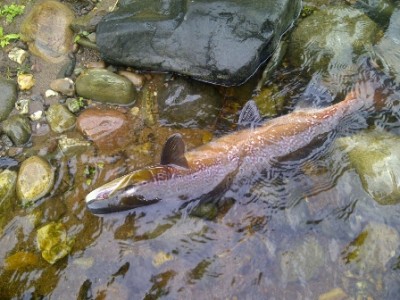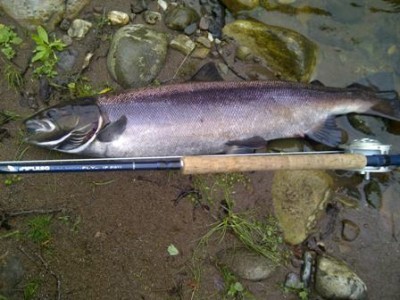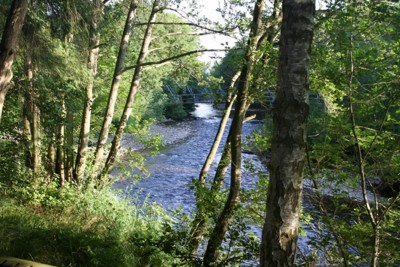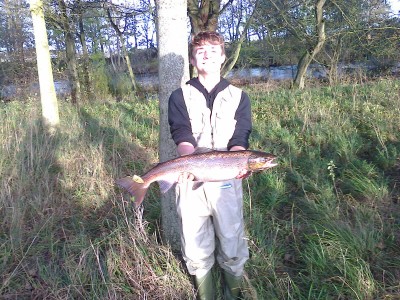PENULTIMATE DAY. LOVELY CLEAN WATER & ONE SALMON
Today was a perfect, slightly misty, autumn day with the light fading away from about 3pm. Our guests were iain Ingledew, Mark Coburn (Fishpal) and Colin Carnie. There were some salmon showing all day long, especially in a Willows, Lower a Boat Pool, Volcano and Pheasantry. They were, as has been the case for all this autumn, very reluctant to take the fly. Nevertheless Mark Coburn had a nice 11lbs hen fish from the taking spot in Willows, immediately after Iain McMaster had encouraged him to drop the fly into the small bay just downstream of the willows. According to Mark the fish took with a quiet authority, as a salmon should! Well done Mark. While enjoying a most convivial lunch, I watched from the DTH veranda a big fresh salmon break the surface no less than 4 times. We tried to persuade it to take the fly by fishing down to it from above the RPJ at the head of the pool. Without success. Tomorrow is the last day of the 2014 season. Our guests are John Wood, Colin Carnie, and Derek Strachan. TA
FCW CATCH OF SALMON REACHES 100
No-one could deny that 2014 has been a tough year on most Scottish salmon rivers. Rivers such as the Spey, Teith, Dee and Thurso have had a torrid time, and their catches reflect that. Here on the South Esk we have been quite well let and there have been fish in the river since March. I wouldn’t claim that either wild salmon or sea trout have been here in big numbers but I can say with a deal of certainty from my own observations and those of people I trust that the River is holding its own in a difficult year. Thus it was with some relief that I heard that Tony Searle had caught an 8lbs cock salmon in Beeches Pool on Castle Pool in conditions that were nigh-on perfect with falling and clearing water, a nippy frost lowering water temperature, no wind and only a few leaves but it was hard going all day long with only the occasional fish showing. But who better to reach our 100 salmon for 2014 than Tony Searle who has given FCW so much support over the years!
THE SOUTH ESK IN GOOD PLY FOR THE END-GAME
Monday started the week with the river in perfect ply. The air temperature was unseasonably warm, and a few leaves lingered in the current, but we really couldn’t complain that late October had sprung a high water surprise on the South Esk. We caught two salmon and a sea trout, but not many fish were seen during the day – certainly far fewer than in the previous week. Interestingly, as dusk fell, there was a good show of salmon in Pheasantry. For readers who don’t know that pool, it is the streamy section of river directly opposite David’s Tree House (DTH). Fish were splashing about in that pool well into the darkness. At least one of the fish caught yesterday came from that pool. Have a look at the map – and click on the pool name “Pheasantry” to see the pool in more detail. This morning (28/10) the river is running at 1’6″ at Gella Bridge and “steady” so, leaves permitting, and the overnight rain avoiding another deluge, we should see some action today. TA POSTSCRIPT OVERNIGHT RAIN SWELLED THE WATER IN THE CATCHMENT WHICH THEN SPILLED OVER INTO THE RIVER, BRINGING A 2′ SPATE. While conditions today weren’t good for fishing, the weather forecast suggests that there will be no more rain. More to the point, it is likely that there will be a sharp frost in the glens which should lower the water temperature and bring salmon onto the take. We are eternal optimists as we strive towards the 100 salmon for the season!
TA
THE LAST FIVE DAYS OF THE 2014 SEASON (and some pictures from the spring & summer)
Overnight the storm blew itself out into the North Sea. This morning the wind is a shadow of its former self – a mere zephyr – and the beech leaves are lying 6″ deep on the lawn. The exhausted trees, after bending and groaning before the full force of the westerly gale are battered and bedraggled, with remaining leaves like shreds of clothing hanging from their skeletal forms. This is the back end of autumn, or the beginning of winter from which we should emerge in five or six months time. It’s a long haul! Today is mild and dull and, although I have yet to look closely at the river, I think it likely that the leaves will be less of an interference than last week. It has also started to rain here while in the West over 6″ of rain has fallen in the last 24 hours. Tony Searle and his two companions will start at 0800 with a meeting at the Milton gate, to be shown the river by Iain. Here’s hoping for keen salmon and satisfied anglers!
TA



